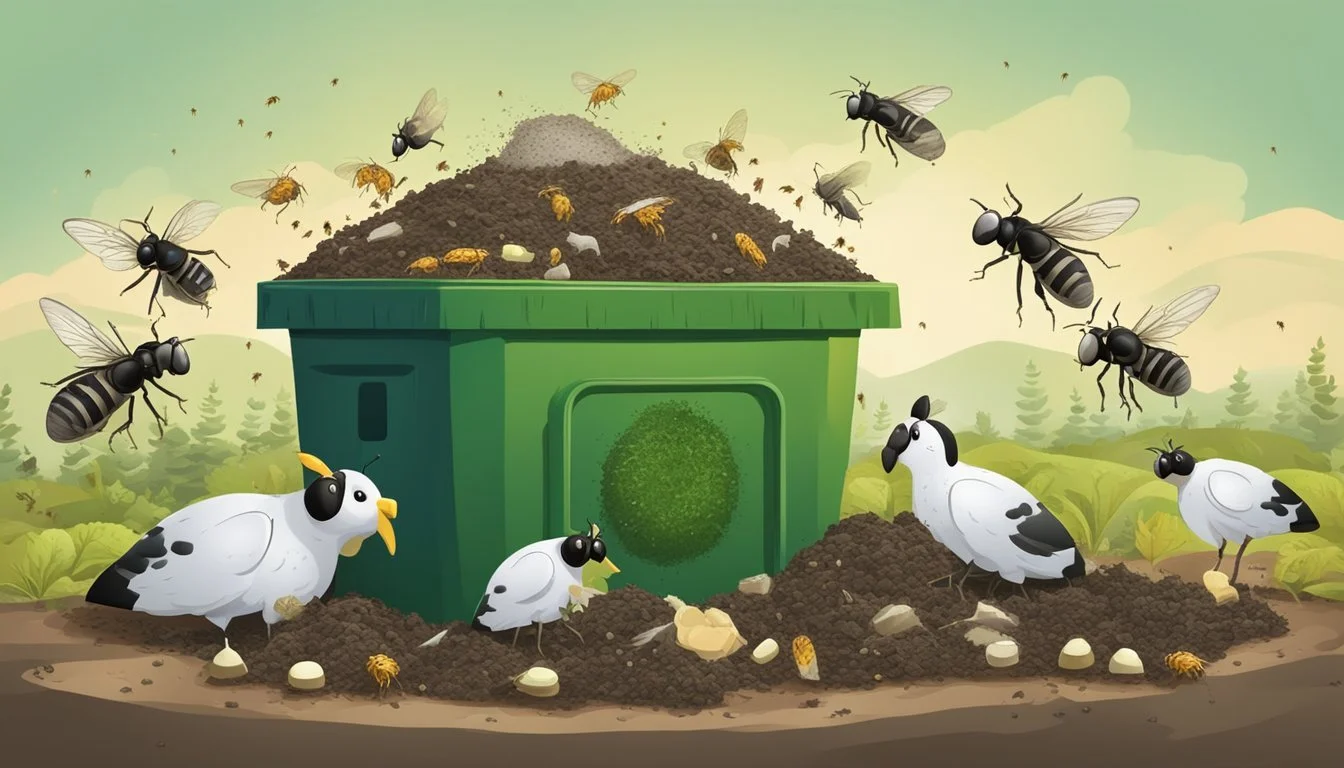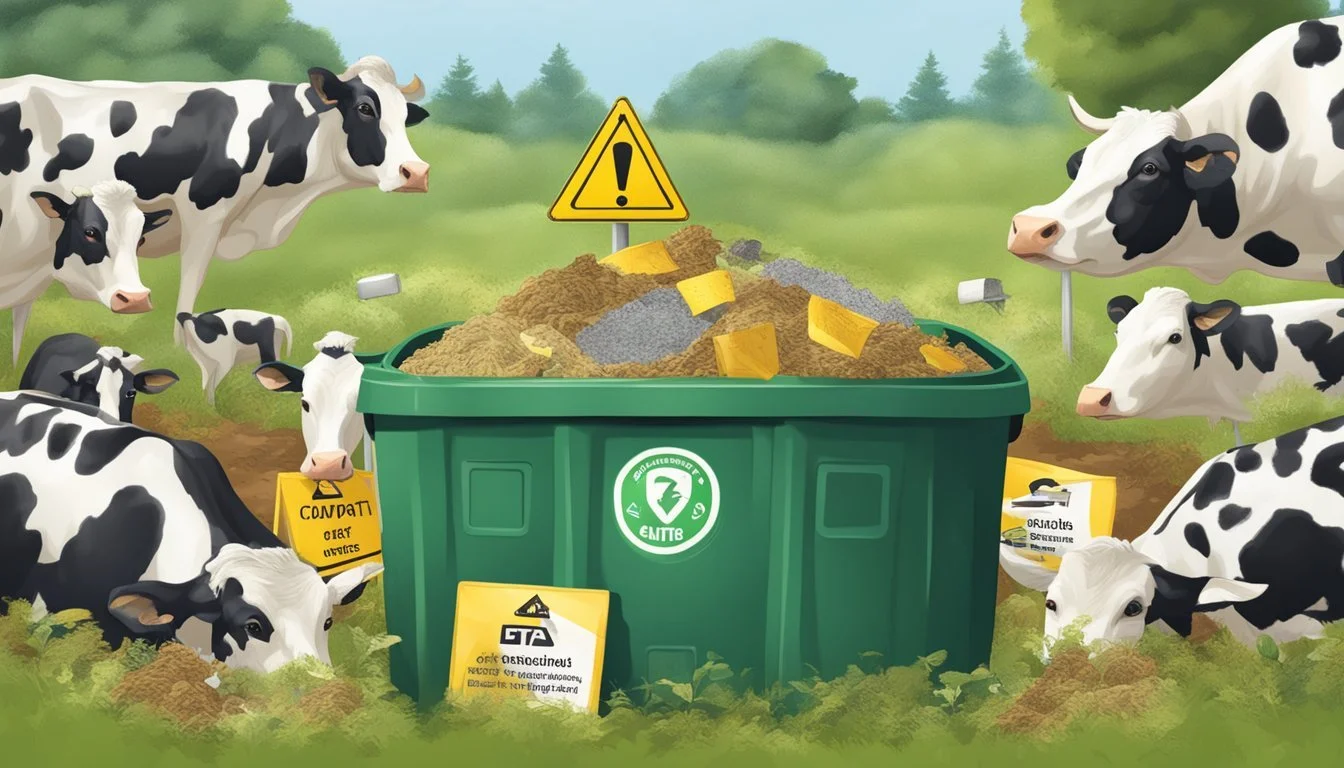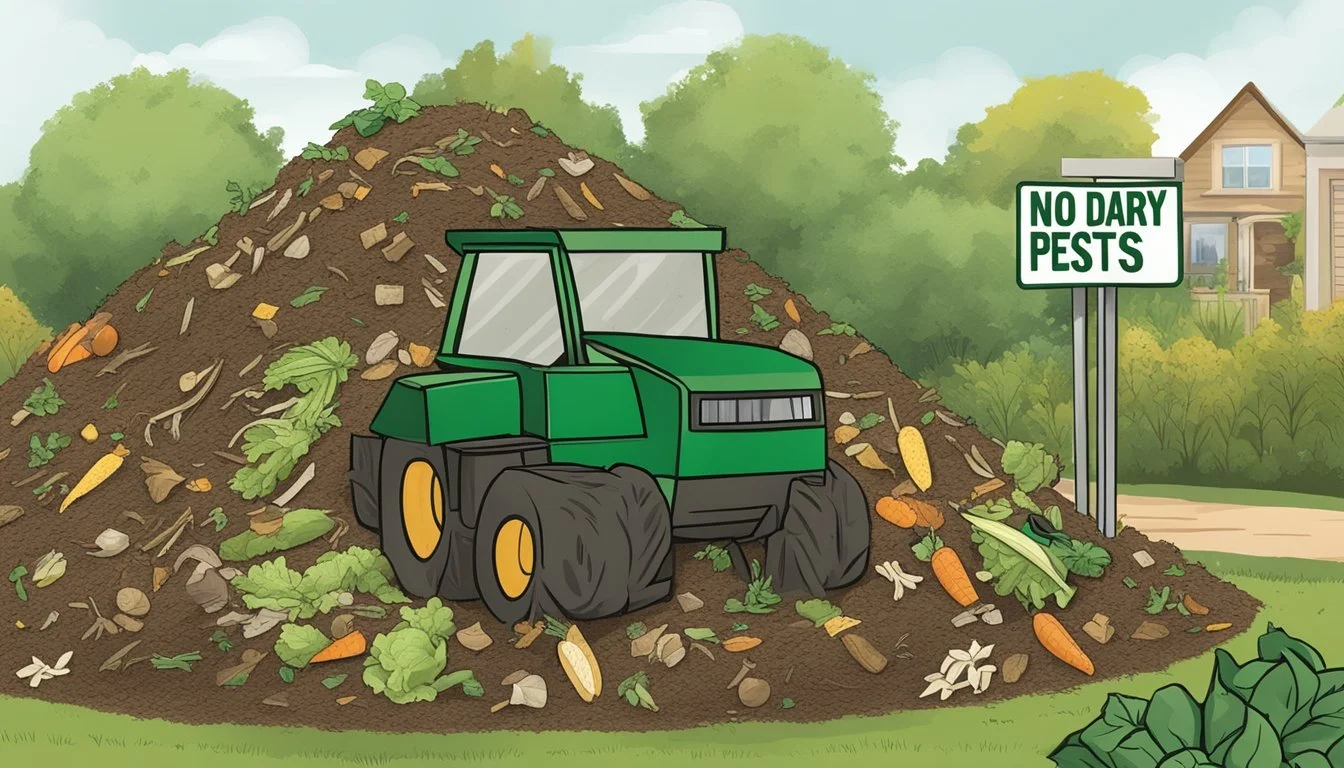Can You Compost Dairy?
Unpacking the Myths and Facts
Composting has become a fundamental practice for reducing waste and creating nutrient-rich soil. When it comes to dairy products, traditional advice has typically steered home gardeners away from adding these items to their compost heaps due to concerns about attracting pests and generating unpleasant odors. However, it is indeed possible to compost dairy with certain precautions in place.
The process of composting dairy products involves a bit more attention than composting vegetable scraps or leaves due to their high moisture content and tendency to decompose with a strong smell. Ensuring that dairy is composted safely requires maintaining a hot compost pile that reaches a certain temperature to accelerate decomposition and prevent the attraction of pests. Proper aeration and covering the dairy with other compost materials like soil, leaves, or sawdust can help contain and minimize any potential issues.
Understanding Composting Basics
The foundation of successful composting starts with grasping the fundamental components of the composting process, including the materials used and the conditions required to turn organic waste into valuable compost.
Defining Compost and the Composting Process
Compost is the end product of the composting process, which is the biological decomposition of organic materials by microorganisms under controlled conditions. The composting process transforms kitchen scraps, yard trimmings, and other organic waste into nutrient-rich soil, promoting sustainability and reducing waste.
Importance of Carbon to Nitrogen Ratio
A critical aspect of composting is maintaining an appropriate carbon to nitrogen (C) ratio. Ideal compost should have a C ratio between 25:1 and 30:1, as it creates an optimal environment for microbial activity. Carbon acts as an energy source for microbes, while nitrogen provides the proteins necessary for microbial growth.
Material Type Carbon Source Nitrogen Source Browns Leaves, Paper Greens Food Scraps, Grass Clippings
Role of Temperature in Composting
Temperature significantly influences composting speed. Hot composting, maintaining temperatures between 135°F and 160°F, accelerates decomposition and kills pathogens. Regularly turning the compost pile ensures uniform heat distribution and maintains aerobic conditions.
Benefits of Composting for Soil Quality
Composting enhances soil structure, retains moisture, and adds essential nutrients, fostering healthy plant growth. Utilizing compost can improve soil fertility and stimulate beneficial microbial activity, diminishing the need for chemical fertilizers.
Common Composting Systems
There are several composting systems suitable for different scales and contexts:
Backyard composting: Utilizes compost bins or heaps and is ideal for gardeners.
Vermicomposting: Involves worms to break down organic matter and is suitable for indoor use.
Bokashi composting: An anaerobic process involving fermentation, good for small-scale composting.
Electric composter: Mechanically speeds up decomposition, beneficial for those with limited space.
Industrial composting: Large-scale composting facilities that handle substantial quantities of organic waste.
Balancing Moisture and Aeration
For successful composting, the pile should remain as damp as a wrung-out sponge. Proper moisture is vital for microbial activity, while excess water can create anaerobic conditions and lead to odor issues. Aeration through turning prevents compaction and supplies the necessary oxygen for aerobic decomposition.
Can You Compost Dairy Products?
Composting dairy products is possible but requires careful consideration due to the unique challenges they present. This section outlines the advantages and disadvantages, along with safe practices and guidelines for composting dairy.
Pros of Composting Dairy
Sustainable waste management: Composting dairy is a form of sustainable waste management. It keeps dairy waste out of landfills and reduces greenhouse gas emissions. Benefits of composting: Adding dairy to compost can contribute nutrients, such as calcium and fats, which can enhance soil quality when broken down properly.
Cons of Composting Dairy
Odors: Dairy products in compost can produce strong, unpleasant odors as they decompose. Attract pests: These odors can attract pests such as flies, rodents, and raccoons to the compost pile.
How to Compost Dairy Safely
Temperature: Maintain your compost pile at a temperature between 120-160°F to optimize decomposition and reduce pathogen risk. Bury it: To minimize odors and pest attraction, bury dairy waste deep within the compost pile, surrounded by high-carbon "brown" materials like leaves or straw.
Guidelines for Composting Dairy
When composting dairy, one must adhere to specific guidelines to prevent issues:
Use a hot composting method to kill potential pathogens.
Avoid adding large amounts of dairy; keep the dairy to a minimal fraction of the compost content.
Balance dairy with carbon-rich materials to maintain compost health.
Comparing Dairy to Other Organic Scraps
Dairy products have a higher fat content compared to most vegetable scraps, fruits, and grains, which can slow down the composting process. Unlike meats, which are also challenging to compost because of fats and the potential to attract pests, dairy does not have the same protein content but still requires careful management to prevent similar issues.
Dealing with Contaminants and Pests
When composting dairy, it's crucial to manage odors, deter pests, and control pathogens. These factors are essential for a successful and hygienic decomposition process.
Addressing Dairy-Related Odors
Dairy products can produce foul odors during the decomposition process due to their rich nutrient content. To minimize this, one must ensure an aerobic environment in the compost pile to speed up decomposition and prevent the anaerobic decomposition that leads to strong smells. Turning the pile regularly and maintaining a balanced mix of green and brown materials will help oxygenate the compost and suppress odors.
Preventing Pests and Rodents
Dairy in compost bins can attract various pests like flies, raccoons, rats, and other vermin. It is advisable to bury dairy waste deeply within the compost or use a composting bin with a secure lid. Here are key strategies:
Enclosure: Utilize a bin with a locking lid or a tumbling composter to physically block access.
Layering: Cover any exposed dairy with a thick layer of browns such as dry leaves, straw, or sawdust.
Managing Pathogens in Dairy Composting
Composting dairy has the potential risk of pathogen growth. To mitigate this, maintain a high compost temperature, ideally between 120-160°F, which will kill most pathogens. Regularly monitor the temperature with a compost thermometer and adjust the pile composition as needed to maintain heat. If the temperature cannot be sustained, consider avoiding composting dairy or use a specialized composting method designed to manage these risks.
Special Considerations for Dairy Waste
When composting dairy products like cheese, milk, and high-fat items such as cream and sour cream, it is important to manage their introduction to the compost pile correctly. Dairy products can provide nutrients to the compost but also attract pests and create unpleasant odors if not handled properly.
Composting Cheese and Cheese Wax
Cheese is rich in fats and proteins, which can be beneficial in small quantities but may lead to issues such as odor and pest attraction. When adding cheese to compost, it should be broken into small pieces to speed up decomposition. Cheese wax is not typically biodegradable, so it must be removed and disposed of separately before composting the cheese itself.
Handling High-Fat Dairy Products
High-fat dairy products include items such as butter, cream, and sour cream. These substances can slow down the composting process and create odors if not balanced with carbon-rich materials, known as browns, such as dried leaves or sawdust. To effectively compost these products:
Mix them thoroughly with browns to promote aeration.
Add them in moderation to avoid saturating the pile with fats and oils.
Incorporating Dairy into Vermicomposting
Vermicomposting involves the use of worms to break down organic waste into vermicompost. While worms enjoy dairy products like cottage cheese (how long does cottage cheese last?), these products should be introduced sparingly into a wormery. Dairy can create acidic conditions and produce odors, which may harm the worms. Key points of introducing dairy into vermicomposting include:
Feed worms dairy in very small amounts to prevent overwhelming the system.
Bury dairy waste deep within the beddings to minimize odors and pest issues.
By considering these aspects, it is possible to include dairy waste in compost effectively, but it requires careful management to avoid common problems associated with dairy product decomposition.
Alternatives to Composting Dairy
When considering dairy waste management, composting might not always be the best option. Alternatives exist that offer sustainable paths for dairy disposal, alleviating concerns of odors and pests often associated with dairy in traditional compost bins.
Using Bokashi Bins for Fermenting Dairy
Bokashi composting provides a unique solution for dairy products. This method employs a sealed container, known as a Bokashi bin, which uses a special mix of microorganisms to ferment waste. Dairy products added to Bokashi bins undergo anaerobic fermentation, significantly reducing the likelihood of pests and unpleasant smells. Once fermented, the waste can then be safely buried in the soil or added to a traditional compost pile for further breakdown.
Landfill vs. Composting for Dairy Disposal
Choosing between landfill disposal and composting for dairy products involves weighing environmental impacts. Landfill disposal of dairy can contribute to methane emissions, whereas composting, although challenging, can be part of a sustainable waste management practice if done correctly. However, when composting at home isn't feasible, opting for a landfill with recycling programs that capture methane for energy might be considered a more practical solution.
Industrial Composting Facilities
For those unable to compost dairy products at home, industrial composting facilities may offer a viable alternative. These facilities are equipped to handle a wide array of organic waste, including dairy products, and often utilize temperature control and containment strategies to expedite the decomposition process while minimizing issues related to pests and odors. It's advisable to check if local waste management services provide such options as part of their recycling programs.
Building a Healthy Compost Pile
A thriving compost pile requires a balance of materials and attention to maintain its productivity. Properly optimized, it can transform various waste materials into rich soil enhancements.
Essential Layers and Ingredients
For a compost pile to function efficiently, it must contain a mixture of 'greens' and 'browns'. Greens include food scraps and yard waste, which are high in nitrogen. Browns are dry materials like dry leaves, cardboard, newspaper, and straw, providing a high carbon content. Both are essential to feed the composting microbes that break down the waste.
Greens: Kitchen scraps, fresh plant material
Browns: Dry leaves, shredded paper, straw, sawdust
Optimizing the Mix of Greens and Browns
The ideal ratio of browns to greens generally falls around 25-30:1, carbon to nitrogen. This balance ensures that the pile decomposes effectively without producing unpleasant odors. A well-mixed pile promotes aeration, crucial for compost health.
Greens (Nitrogen-rich material)
Kitchen scraps (e.g., vegetables)
Fresh yard waste
Browns (Carbon-rich material)
Cardboard (shredded)
Newspaper (non-glossy, shredded)
Dry leaves and straw
Monitoring Compost Health and Maintenance
Regularly check the temperature of the pile to ensure it's hot enough for decomposition but not so high as to annihilate beneficial organisms. Additionally, the texture should be crumbly, not too wet or dry, and the odor should be earthy, not foul. Turn the pile occasionally to introduce air and redistribute materials, which aids in breaking down tougher components like cardboard and straw.
Compost thermometer: Tool to monitor temperature
Turn the pile: Aerates and mixes materials
Fostering a healthy compost pile facilitates the conversion of organic waste into nutrients that boost plant growth, ensuring a closed-loop, sustainable system.
Practical Tips for Composting Dairy
Composting dairy requires a deliberate approach to maintain the balance in a compost pile and to facilitate effective decomposition. Here are specific ways to compost various dairy products successfully.
How to Compost Cheese and Yogurt
Cheese:
Type: Choose natural, less processed cheese.
Method: Cut into small pieces and mix with carbon-rich materials, like dry leaves or sawdust.
Yogurt:
Quantity: Add in small quantities.
Mixing: Ensure the yogurt is thoroughly mixed into the compost to avoid clumping and to promote aeration.
Reducing Dairy Waste at Home
Start Small: Gradually introduce dairy into compost to prevent overwhelming the system.
Maintain Balance: Keep a proper balance by adding equal parts of green (nitrogen-rich) and brown (carbon-rich) materials.
Prevention: Opt for buying less dairy or in smaller quantities to reduce potential waste.
Troubleshooting Common Dairy Composting Issues
Odor: If the compost smells due to dairy:
Turn: Regularly turn the compost to aerate.
Balance: Add more brown materials to absorb excess moisture and suppress odor.
Bury: Bury dairy deeper in the pile to minimize the scent.
Pests: If pests become a problem:
Secure: Ensure the compost area is secure with proper enclosures.
Hot Compost: Maintain internal temperatures between 135°F and 160°F to promote decomposition and deter pests.
Slow Decomposition:
Size: Reduce the size of the dairy waste to increase surface area for microbes.
Aeration: Turn compost more frequently to provide sufficient oxygen.
Moisture: Monitor moisture levels — it should feel like a wrung-out sponge.
Conclusion
Composting dairy products is a feasible practice for those seeking to recycle nutrients and minimize waste. Dairy products can be composted, but specific conditions and careful management are necessary to avoid attracting pests and producing unpleasant odors.
Temperature Management: Maintaining a compost pile temperature between 120-160°F is crucial for optimal decomposition and for killing potential pathogens.
Layering Technique:
Nest Dairy Waste: Place dairy waste in the core of the compost pile.
Dry Brown Materials: Start with dry, carbon-rich materials like leaves or straw beneath the dairy waste.
Thick Top Layer: Cover with a substantial layer of compost to create a bio-filter and to hasten breakdown.
Quantity Control:
Add dairy sparingly. Large amounts can disrupt compost balance.
Those interested in incorporating dairy into their compost should also consider the type of dairy; some items may break down differently. Additionally, regular monitoring of compost moisture and temperature promotes efficient decomposition and reduces the likelihood of problems.
In summary, with proper management techniques, composting dairy can be a valuable component of a balanced composting strategy.
Resources
When seeking guidance on composting dairy products, there are multiple resources available to provide information and support. These resources range from educational materials to community discussions and professional services, ensuring that individuals have access to comprehensive and reliable information.
Further Reading and Educational Material
For those looking to deepen their understanding of composting dairy products, numerous books, articles, and research papers are available. Resources such as "Composting At Home" by the US EPA offer a foundational understanding of the composting process. Local libraries and bookstores may carry titles specific to sustainability and composting practices.
Books: Seek titles on organic waste management and sustainable farming.
Articles: Look for reputable gardening magazines and journals.
Research Papers: Access academic databases for in-depth studies on composting.
Community and Online Forums
Online platforms provide communal spaces where one can discuss and exchange ideas on composting dairy. Forums such as Reddit's r/composting or the composting sections of gardening websites can be rich sources of shared experiences and tips.
Discussion Groups: Find platforms like GardenWeb or The Compost Bin to ask questions.
Social Media: Follow hashtags such as #composting or #sustainableliving on platforms like Instagram or Twitter.
Professional Consultation and Services
For personalized advice or services, reaching out to local agricultural extension offices or professional composting services can yield tailored recommendations and possible on-site assistance.
Extension Services: Contact your local university extension program for expert guidance.
Composting Services: Hire professionals for consultation or to manage composting directly.
Frequently Asked Questions
In this section, readers will find clear and concise answers to common queries about composting dairy products, focusing on the inclusion of milk, various types of cheese, safety precautions, and the effects on compost temperature.
Can You Add Milk to Compost?
Adding milk to compost is possible; however, it should be done with care. Milk has a high moisture content which can benefit the composting process, but it can spoil and create odors that attract pests. For home composting, dilute milk with water and add it in small amounts to avoid any issues.
What Kinds of Cheese Can You Compost?
When it comes to cheese, hard cheeses are generally more compostable than soft cheeses due to their lower moisture content. Regardless of the type, cheese should be chopped or shredded to increase the surface area and speed up the composting process. Avoid adding large amounts as it may lead to similar issues as with composting milk.
Is it Safe to Compost Dairy at Home?
Composting dairy at home is safe if one strictly manages the compost to prevent the attraction of pests and the potential for disease. This involves maintaining a balanced compost, avoiding excess dairy, and ensuring there is enough carbon-rich "brown" material in the compost to offset the nitrogen-rich dairy products.
How Does Dairy Affect Compost Temperature?
Dairy products can influence the temperature of a compost pile. For dairy to decompose efficiently without causing a foul smell or attracting pests, the pile should maintain a temperature between 120-160°F. This is often achieved through hot composting methods where the heat generated by the composting process breaks down the dairy products effectively.








